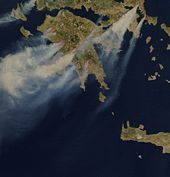
Back مؤشر جودة الهواء Arabic Індэкс якасьці паветра BE-X-OLD हवा क्वालिटी इंडेक्स BH མཁའ་རླུང་སྤུས་ཚད་སྟོན་གྲངས། BO Índex de Qualitat de l'Aire Catalan Mynegai ansawdd aer CY Luftgüte German Índice de calidad del aire Spanish Airearen kalitate indize EU شاخص کیفیت هوا FA

| Part of a series on |
| Pollution |
|---|
 |
An air quality index (AQI) is an indicator developed by government agencies[1] to communicate to the public how polluted the air currently is or how polluted it is forecast to become.[2][3] As air pollution levels rise, so does the AQI, along with the associated public health risk. Children, the elderly and individuals with respiratory or cardiovascular problems are typically the first groups affected by poor air quality. When the AQI is high, governmental bodies generally encourage people to reduce physical activity outdoors, or even avoid going out altogether. When wildfires result in a high AQI, the use of a mask (such as an N95 respirator) outdoors and an air purifier (incorporating both HEPA and activated carbon filters) indoors are also encouraged.[4][5]
Different countries have their own air quality indices, corresponding to different national air quality standards. Some of these are Canada's Air Quality Health Index, Malaysia's Air Pollution Index, and Singapore's Pollutant Standards Index.
- ^ "International Air Quality". Archived from the original on 12 June 2018. Retrieved 20 August 2015.
- ^ "Create a Clean Room to Protect Indoor Air Quality During a Wildfire". U.S. Environmental Protection Agency. 12 December 2018. Retrieved 2023-08-03.
- ^ "MACC Project - European Air Quality Monitoring and Forecasting". Archived from the original on 2014-10-18. Retrieved 2014-10-12.
- ^ "Create a Clean Room to Protect Indoor Air Quality During a Wildfire". epa.gov. November 1, 2023. Retrieved February 12, 2024.
- ^ "How to mitigate post-fire smoke impacts in your home". Cooperative Institute for Research In Environmental Sciences (cires.colorado.edu). January 4, 2022. Retrieved February 12, 2024.